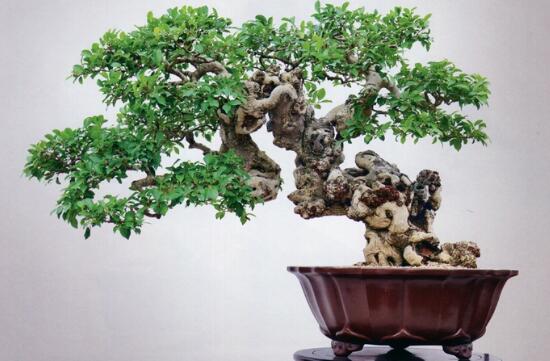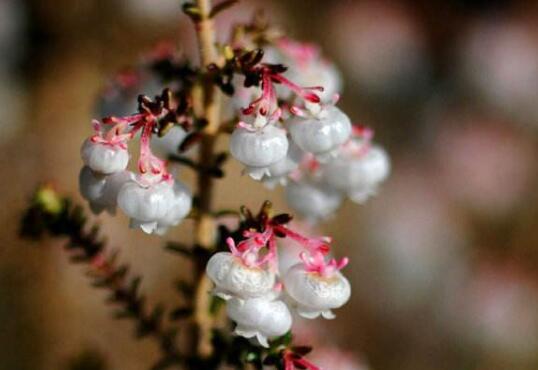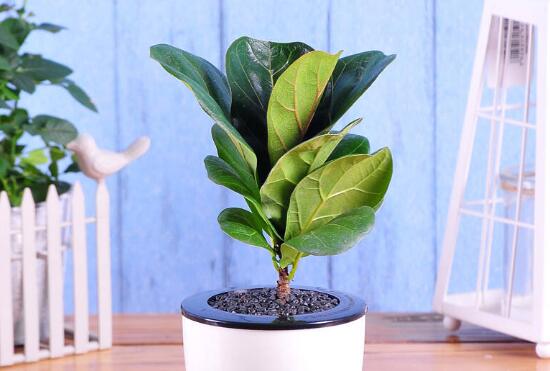What is the root of the banyan tree, how to cultivate the root of the banyan tree?/3 recruit to cultivate the perfect root of the banyan tree
The beauty of banyan bonsai lies not only in its unusually developed roots, but also in its leafy upper body, which is highly ornamental when placed indoors or raised in the open air. In life, it is often heard that the air root of the banyan tree will be very good-looking, so what is the air root of the banyan tree? How to cultivate air root of banyan tree? Today, the editor is here to solve this problem for everyone.
What is the aerial root and bare root of banyan tree

With regard to the air root of the banyan tree, it is easy to understand that it refers to the root exposed to the air. The air root of banyan tree grows in order to adapt to the environment of high rainfall, high temperature and high humidity in the south, and it can assist respiration. Whether it is made into bonsai or planted in the open air, banyan trees will have air roots, which can improve the ornamental quality of banyan trees. Let's take a look at the cultivation methods of banyan air roots.
2. How to cultivate the aerial root of banyan tree, mode / method (1) the formation mode of aerial root of banyan tree
1. Natural formation
When it comes to the formation of the air root of the banyan tree, in fact, it will be formed naturally. Some of these air roots grow vertically downward, some hang in the air, and some are inserted into the soil after reaching the ground to support and absorb. Of course, the natural formation of air roots are not good-looking, which is also the origin of artificial cultivation of banyan air roots.
2. Artificial cultivation
The natural air root of the banyan tree is always difficult to make people feel beautiful, so in order to increase its beauty, people often use physical or chemical roots to force the banyan tree to grow air roots where they need to grow roots. As for how to cultivate the aerial root of banyan tree, there are three methods: grafting method, half-broken branch method and binding method, and how to do it? let's move on.
(2) the culture method of aerial root of banyan tree.
1. Time
Before cultivating the aerial root of the banyan tree, we have to do some preparatory work, such as time. Generally speaking, the aerial root of banyan tree can be cultivated all the year round, but spring is the most suitable. Because the temperature rises gradually in spring, Rain Water increases, which is conducive to plant growth.
2. Methods
① connection method
The key lies in a small banyan tree with more roots, close to the branches of the banyan tree that needs angry roots, and then connect them together like grafting. After success, the small banyan pots and soil were removed, thus completing the cultivation of air roots.
② half-broken branch method
On the branch of the banyan tree that needs to cultivate air roots, make a small cut to the woody place, then gently break it with your hand and plug the wound with mud. After a period of time, some small air roots will grow at the fracture, and then the lateral roots will be guided to grow downward, which will have a very good effect.
③ binding method
Tie the wire to the branches of the banyan tree that need to cultivate air roots, so that the sap cannot flow, and then apply moss on the binding. Soon, milky root buds will be produced at the binding, and then we use soil to make these roots grow until they reach the ground, so that we can complete the cultivation of air roots.
How to cultivate the aerial root of banyan tree
Selection of banyan species and cultivation time
If we want to cultivate the aerial roots of banyan trees, the selection of banyan varieties is also very important. Not every banyan tree is suitable for cultivating aerial roots. We should choose those banyan varieties that are easy to grow aerial roots, such as fine-leaf banyan, alpine banyan and so on. In fact, the air root of banyan can be cultivated all the year round, but the most suitable time is in the wet and warm spring.
Cultivation of aerial root of banyan tree by grafting method
We can directly graft the small banyan tree with more roots into the banyan tree, plant it directly on the banyan tree that needs to cultivate the air root, and wait until the small banyan tree grows on the banyan tree to remove the pot. in this way, the cultivation of air root is completed.
Cultivation of aerial Root of Banyan Tree by half-broken Branch method
We need to make a small cut in the long trunk that needs to cultivate the air root, cut it to the wood, break it slightly, and then apply mud on the small opening, and after a period of time, some small air roots will grow. Then we just need to guide these air roots down, and then we can have a very good effect.
Cultivation of aerial Root of Banyan Tree by binding method
To cultivate the air root in this way, we need to tie the iron wire tightly to the branch that needs to cultivate the air root, tie the wire so that the sap of the banyan tree cannot flow, and then cover the place where the wire is bound with moss, after a period of time, small white bud roots will grow in the wound where the wire is bound, and then we use soil to make these bud roots grow and grow until they grow to the ground. In this way, we can complete the cultivation of air root.
The cultivation of air root tuber root of banyan tree should have the correct direction and purpose for the cultivation of air root and tuber root, and should not make the air root thick and hard, straight as bamboo pole, or braided, or wound up and down the tree trunk, which is vulgar. It is not good to blindly pursue many tuber roots and large tuber roots, regardless of whether the plant shape can match or not, and be blindly curious. The cultivation of air root should be thin, less and fine, not thick and chaotic. Air root is the "affection" of banyan tree, which is born when the water demand of branches and leaves exceeds the water supply of tree trunk. Should use its law to carry on the modelling.
For example, cultivating the air root of the top node main branch can make the branches and leaves fully luxuriant and self-angry. Can also be supplemented by artificial, in addition to one side to make the branches and leaves luxuriant, at the same time with a small water bottle next to the plant, with gauze strips to lead water to the branches of the air root culture, so that that part of the branches often have water, you can quickly angry roots. In case the root is still not angry because the plant is weak, you can also take the method of engraving, that is, 1 mm below the point where the root is needed, the wound is as deep as xylem with a knife, and the wound is 1 mm wide. other measures are still the same as above, when the root can be angry. This method can be carried out when the branches and leaves are most luxuriant in summer, and the air root must be attached to the gauze strip. However, as soon as the air root hits the soil, it is very easy to grow and thicken, which in turn promotes the branches and leaves to grow more luxuriantly, so it is appropriate to control the branches and leaves in time. If necessary, cut off the air root in the soil, and do not let the air root grow too thick.
If you can't control it again and again, cut off half or all of the air root. If you inadvertently make the air root grow too thick, that section of the branch is swollen, shaped like "crane knee", extremely ugly. On the contrary, the thickness of the air root is very appropriate, and it does not continue to grow thick, but in the following spring pruning, after all the twigs and leaves are cut off, that is, the thinner air root will soon lose its function and be naturally eliminated. The angry root is more likely to die by the method of scratching. Therefore, the cultivation of this kind of air root should be carried out from the Qingming Festival to the Beginning of Summer, because by cutting off twigs and leaves, the air root will sprout and grow new leaves soon, and the air root will not be eliminated so quickly. In addition, a transitional method can be adopted, that is, some of the branches and leaves can be cut off before the Qingming Festival, and then cut off the rest after Grain Rain or when the Beginning of Summer has already grown new leaves. Cultivate the air root attached to the trunk, can be thicker than the air root of the top section, can be buried for a long time and mixed with the trunk, increase the aging of the trunk, increase the beauty of the potted plant, and should make it naturally elongate. In the case of chaos or too much, it can be guided or cut off manually, and it should not be deliberately twisted and braided, because this kind of air root is attached to the trunk, and it will be difficult to remedy later. Because of the poor growth conditions, few of the seedlings of banyan trees dug up from the mountain have tuberous roots, while most of the seedlings cultured in seedling bed have tuberous roots.
After cutting, the cultivation methods for seedlings with tuber roots are: plants dug from the mountain with relatively complete roots are 30 or 40 years old, and those with better root shape can expose 60% of the soil surface when entering the basin, so that the roots are not easily deformed. If the root is seriously injured or unsightly dug from the mountain, the root wound should be coated with plant ash before entering the basin, air-dried (leaves and branches should be sprayed with water), and then into the basin, 10% or even all of it can be buried in the soil. After survival, it should be observed at any time and take root from the base in a hurry, so that the injured root can continue to grow and can easily take root. If the root is ugly, when entering the basin, a stone of appropriate size can be placed in the protruding and uneven place of the root, and the soil can be properly pressed so that the rest of the root continues to grow, while the part with stone is not easy to grow because of pressure. Use this method to deform the root and make it beautiful. Seedlings with tuber roots taken from the seedling bed, such as those with poor root shape, should also be treated with the above method, and those with good root shape should be buried in the soil for 70% to 80%, so that the root tuber can continue to grow.
For plants with tuber roots, do not often lack water, cut too much or fertilize too much, otherwise the roots will rot or rot. In the process of culture, attention should be paid to the cooperation between root tuber and tree trunk at any time. The multi-root should be tight, the air root should be less and thin, and the root should be mainly reflected in the root. And the root is like a mountain, like a stone, and the trunk is like a stone, then the two can not be disjointed, otherwise, it will not increase its beauty, but will be vulgar.
- Prev

How to raise potted heather, breeding methods and precautions / avoid bright light
Photinia is a kind of flower plant native to Africa, which has high ornamental value. Nowadays, it is cultivated in all parts of our country, but there are many places that need to pay attention to if we want to raise it well. About how to raise potted heather? What are the culture methods and matters needing attention of Photinia paniculata
- Next

How to cultivate figs with Qin leaves? methods and precautions for cultivation of banyans with leaves of Qin
Qin leaf banyan, an ideal indoor potted plant, has large and good-looking leaves, and can promote fengshui at home when raised indoors, so it is deeply loved by flower friends. In life, when the efficacy of Qin Ye Banyan is found, many people want to raise it, so how to raise it?
Related
- Fuxing push coffee new agricultural production and marketing class: lack of small-scale processing plants
- Jujube rice field leisure farm deep ploughing Yilan for five years to create a space for organic food and play
- Nongyu Farm-A trial of organic papaya for brave women with advanced technology
- Four points for attention in the prevention and control of diseases and insect pests of edible fungi
- How to add nutrient solution to Edible Fungi
- Is there any good way to control edible fungus mites?
- Open Inoculation Technology of Edible Fungi
- Is there any clever way to use fertilizer for edible fungus in winter?
- What agents are used to kill the pathogens of edible fungi in the mushroom shed?
- Rapid drying of Edible Fungi

